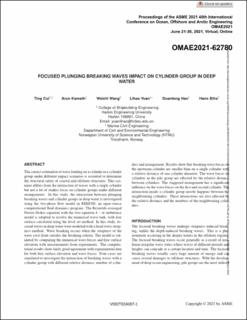Focused Plunging Breaking Waves Impact on Cylinder Group in Deep Water
Chapter
Published version

Åpne
Permanent lenke
https://hdl.handle.net/11250/2990098Utgivelsesdato
2021Metadata
Vis full innførselSamlinger
Originalversjon
10.1115/OMAE2021-62780Sammendrag
The correct estimation of wave loading on a cylinder in a cylinder group under different impact scenarios is essential to determine the structural safety of coastal and offshore structures. This scenario differs from the interaction of waves with a single cylinder but not a lot of studies focus on cylinder groups under different arrangements. In this study, the interaction between plunging breaking waves and cylinder groups in deep water is investigated using the two-phase flow model in REEF3D, an open-source computational fluid dynamics program. The Reynolds-averaged Navier-Stokes equation with the two equation k–Ω turbulence model is adopted to resolve the numerical wave tank, with free surface calculated using the level set method. In this study, focused waves in deep water were modeled with a fixed wave steepness method. Wave breaking occurs when the steepness of the wave crest front satisfies the breaking criteria. The model is validated by comparing the numerical wave forces and free surface elevation with measurements from experiments. The computational results show fairly good agreement with experimental data for both free surface elevation and wave forces. Four cases are simulated to investigate the interaction of breaking waves with a cylinder group with different relative distance, number of cylinders and arrangement. Results show that breaking wave forces on the upstream cylinder are smaller than on a single cylinder with a relative distance of one cylinder diameter. The wave forces on cylinders in the pile group are effected by the relative distance between cylinders. The staggered arrangement has a significant influence on the wave forces on the first and second cylinder. The interaction inside a cylinder group mostly happens between the neighbouring cylinders. These interactions are also effected by the relative distance and the numbers of the neighbouring cylinders.